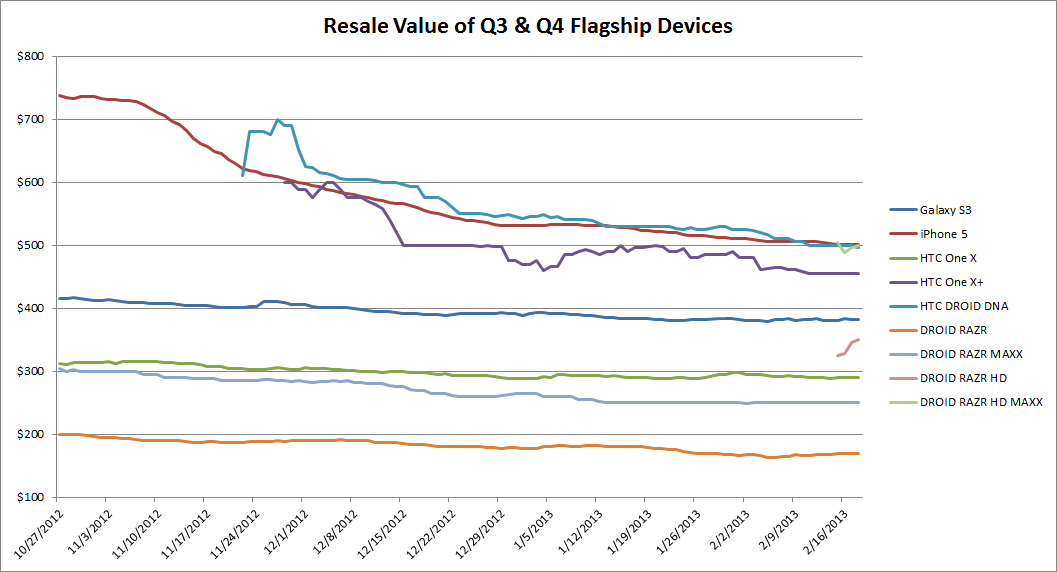Every 2 years we spend our hard earned money on what we hope is the best phone around. Sometimes however, what we thought was going to be the flagship device of our hearts, merely turns out to be a dinghy. What are we to do then? Sell it so we can fund our device lust but of course!
Which flagship devices have the best chance of getting your money back? We took a look at all the flagships from the major OEMs available in the U.S. and found some interesting results:
Note: The Motorola RAZR HD and RAZR HD MAXX were just recently added to the database but have been available since 10/18/2012
Now, before we jump to any conclusions, let’s keep in mind that Motorola’s original DROID RAZR lineup was released right at the start Q1 of 2012 while the Galaxy S III and One X were released late in Q2 of 2012. The RAZR is in reality running a model year older processor technology and doesn’t technically compete with either Galaxy S III or One X, which is reflected in its relatively low resale value. However, there is a clear difference between the Galaxy S III and One X, which were released less than 30 days apart and run the same Qualcomm chipsets. The Galaxy S III consistently bested the One X by about $90 every month.
Another interesting bit of information we can glean from this chart is the initial value of Android vs. Apple devices. The 3 devices with the highest resale value are-not coincidentally-the 3 newest devices: the iPhone 5, One X+ and Droid DNA. All 3 devices were released within three and a half weeks of each other, but the iPhone 5’s peak resale value is considerably higher (and stays that way) than the Droid DNA and One X+. You will also notice that the decline in resale value is also very steady, whereas the Androids tend to fluctuate.
There is a clear hierarchy between competing device OEMs in the secondary market for smartphones, and if you are trying to make money or save money, the most important decision can be which phone you buy and when. Ever since Motorola’s acquisition by Google, there has been significantly less buzz about their devices. This has led to a lower premium on the brand itself, resulting in even their newest phone (Droid RAZR HD), to average for $357 today (2/25/13), $30 less than the going price for a Galaxy S III launched 9 months ago.
HTC has tried hard to push their image as a cutting edge hardware designer with a focus on quality over quantity, and in turn have released some beautiful devices. They are however unable to compete with Samsung’s outright massive popularity. What part is due to the device itself and what part is due to their huge marketing campaign isn’t clear, but their presence in the secondary market is impossible to ignore. Speaking of things that are impossible to ignore, the iPhone still hails king over 5 generations of devices, at least in terms of resale value. These devices command such high demand you can make a pretty profit flipping your phones the day of their release: pay $199 on contract, sell for $700+ the next day.
Bottom line? Remember that resale hierarchy I mentioned earlier? It goes something like this:
1. Apple $$$$
2. Samsung $$$
3. HTC $$ - $$$
4. Motorola $
Buying a Galaxy S III or iPhone 5 are the safe bets for getting the most money back if you do decide to sell before your 2 years are up. Essentially, if you stick with the Galaxy S or iPhone lineup, you will be good to go. If you dare venture to HTC, Motorola, or LG territory, you’ll probably be better off using it for the full 24 months unless you want to take a hit in the wallet. Oh, what about Windows Phone 7? Let’s just say you’ll


